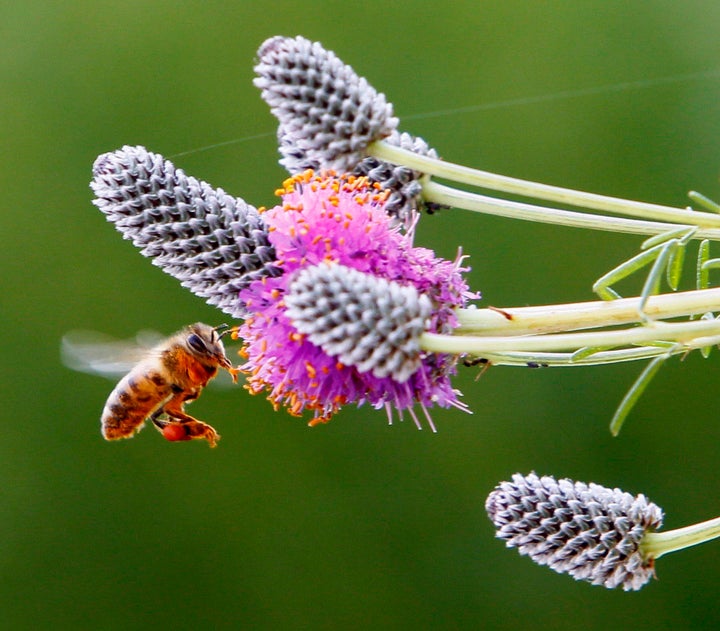
More than a half a century ago one of the most recognized scientists and arguably brightest mind ever - Dr. Albert Einstein said, "Our task is to widen our circle of compassion beyond a few people to embrace all living creatures and the whole of nature in its beauty." To encompass this Einstein loved the beauty of bees.
Of the more than 1.6 million known forms of life on our home -- planet Earth, bees truly are the "golden-hair" pollinator partners that have been entrusted with sustaining life on land.
Consider that at least 20,000 but perhaps as many as 40,000 species of solitary, stingless, bumble and honeybees quietly have gone about enriching the tapestry of life for over 100 million years.
Our early ancestors perhaps as far back as the Old Stone Age, millions of years ago, and certainly in the Middle Stone Age (beginning around 280,000 years ago) revered the bees and sought their honey because it's the sweetest natural substance that nature has to offer.
Drawings carved into rock-walls, called petroglyphs, in almost 400 sites in 17 regions -- including Europe, North and South Africa, India, Malaysia, Indonesia and Australia recorded the cherished "honey-hunts" in spectacular details.
I'm constantly encouraging my students to travel. For those privileged enough to have visited any of the honey-hunting petroglyphs -- there is an incredible energy and mysticism that's exuded through this art. Researchers hypothesize that some honey-hunters were actually clan shaman, reputed to have supernatural powers.
Throughout the ages people have been fascinated with bees and for many good reasons.
Take for example a honeybee hive. It's a city of about 100,000, mostly females, governed by a queen, who runs a very tight and highly profitable food service industry with zero unemployment amongst workers.
The industry begins before sunrise and continues to operate seamlessly until well after sunset. Like any one of our human industrial operations, honeybees work with up-to-date information. Bees, unlike humans, are able to quickly change their production lines and in a matter of minutes, tens of thousands of worker bees update their memory banks and immediately begin new tasks -- all for the common good of the city or hive.
I suspect that William Shakespeare spent many hours watching honeybees around Stratford-upon-Avon for he, too, was intrigued with them and wrote about bees in Henry V: "For so work the honeybees, creatures that by a rule in nature teach the act of order to a peopled kingdom."
And it turns out, each year, that not only do honeybees give humans 2.65 billion pounds of honey; 44 million pounds of beeswax (for which the Roman Catholic Church uses 3.1 million pounds in candles); cotton to cloth us; powerful bee venom or apis drugs that offer relief to those suffering from rheumatoid arthritis, multiple sclerosis, fibromyalgia and tendonitis; but also of the 100 crop species providing 90 percent of the world's food -- about 74 percent are pollinated by bees.
Bumblebees are two to three times bigger than honeybees, visit two to three times more flowers than their smaller brethren, resulting in 16 hour works days, seven days a week. In fact, helicopters mimic the same aerodynamic principles used by bumblebees to lift-off and fly. Helicopters use reverse-pitch semi-rotary blades. Each time bumblebee's wings swing back and forth (one oscillation cycle), a type of cavity or vacuum is produced in the air above the wing. This cavity provides extra lift for the large bumblebee and her heavy payload of pollen, nectar, water or tree resin.
Bumblebees are helping humans solve the age-old question that the traveling salesman constantly grapples with: how to find the shortest path that allows him to visit all locations along his route. Although their brains may be the size of a pinhead, bumblebees clearly show advanced cognitive capacities with very few neurons.
Today we are one step closer to understanding how bumblebee brains work because of ground breaking research conducted by 28 British schoolchildren aged 8 to 10 who discovered that buff-tailed bumblebees (Bombus terrestris) use a combination of colors and spatial relationships in deciding which color of flower to forage from.
The facts are that bees and humans share a number of remarkable similarities: we both like sleep, enjoy nicotine, cocaine, perfume, voting; and as we age -- our memories begin to fade.
The honeybee hive is a superlative architectural masterpiece. It takes 66,000 bee hours of activity to produce 77,000 splendid hexagonal cells that form the comb of the hive. It takes about 20 pounds of honey for young worker bees to produce 2.2 pounds of beeswax. Bees eat the honey and trigger a gland in their abdomen to secrete wax. That 2.2 pounds of beeswax is then magnificently engineered into chambers, back-to-back, at exactly a 13-degree angle to prevent 48 pounds of honey from dripping out.
Many decades ago, the aeronautics industry recognized the phenomenal strength of the honeycomb and adapted nature's flawless honeybee design to enhance the bending and stiffness of all aircraft wings, as the wings support heavy fuel loads in the aircrafts.
Nobel laureate Dr. Karl von Frisch (1886-1982) dedicated his life to unraveling the many mysteries of the honeybee. The bee waggle-dance is indeed one of the most extraordinary forms of communication in the entire animal kingdom. This dance conveys precise information about the food's location, including its direction and distance from the hive -- as far as 8 miles away.
There are, very thankfully, at least two known healthy populations of honeybees in remote locations on our home -- planet Earth. They remain disease-free, offering new genetic traits to bolster our beleaguered, worldwide, bee populations against the toxic world we have inadvertently created. One population was recently located in Libya's Kufra Oasis and the other exists on the least populated and most remote jurisdiction in the world, the Pitcairn Islands.
Please support your local beekeepers; Google them and buy their honey -- it's an excellent, practical holiday gift.
In these very troubling times that we are living-in; let's all take a moment, drift back to 1928, smile and dance with Cole Porter's mellifluous lyrics... "Birds do it. Bees do it. Even educated fleas do it. Let's do it, let's fall in love!"
Earth Dr. Reese Halter is an award-winning science communicator: voice for ecology and distinguished conservation biologist at California Lutheran University. His latest books are "The Incomparable Honeybee" and "The Insatiable Bark Beetle." Contact Earth Dr. Reese Halter.
